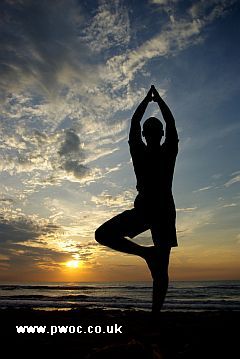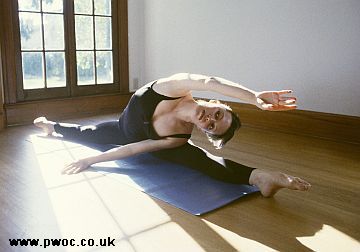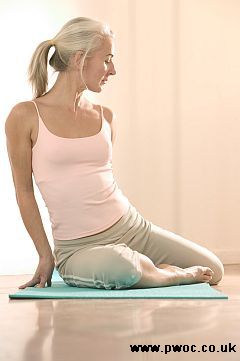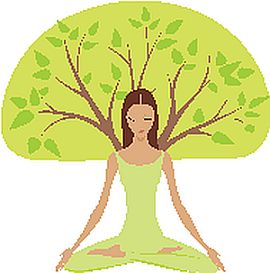Hatha Yoga Petts Wood 
Welcome to Simon Tolsons' Yoga Studio in Petts Wood
Hatha yoga is one of the best known and widespread. The name is derived from the Sanskrit Ha, which stands for the female principle and Tha, the male principle - implying that yoga is practiced by both men and women with the objective of achieving complete control of the body. Hatha Yoga demands high personal standards. Patanjali gave us the blueprint for ways to unite the body, mind and spirit. One of the most common ways, he tells us, is through asanas, or postures. This is Hatha yoga which uses the body to change the internal state of mind and consciousness.

Hatha Yoga Asanas.
There are about 200 asanas in Hatha yoga, each with its own distinct form dictated by stretching, counter-stretching, and resistance. Good alignment of the muscular and skeletal structures is a major focus of the asanas. Adding a conscious breathing pattern to the postures circulates energy and blood and brings balance to the sympathetic and parasympathetic nervous system, which serves the autonomic function of just about every system in the body. Pranayama comes from two Sanskrit words: "prana" which means life force or life energy, and "yama", which means discipline. Pranayama is the practice of breathing and energy circulation.

The Yoga Sutras
In his Yoga sutras Patanjali describes as asana as having two important qualities, which are "sthira" and "sukha". Sthira means steadiness and alertness; Sukha means ease and comfort. Both of these should be used in yoga asanas. Always begin from where you are. If you have a stiff back, you have to acknowledge this is your starting point and work with the postures from here. Progress with steadiness, alertness, ease and you will remain in comfort. Your breath is the key link between your inner and outer body. Allow every movement to be led by the breath. Allow the body to surrender it's tension using the breath and move further into poses during the out breath.

The Yoga Sutras
In his Yoga sutras Patanjali describes as asana as having two important qualities, which are "sthira" and "sukha". Sthira means steadiness and alertness; Sukha means ease and comfort. Both of these should be used in yoga asanas. Always begin from where you are. If you have a stiff back, you have to acknowledge this is your starting point and work with the postures from here. Progress with steadiness, alertness, ease and you will remain in comfort. Your breath is the key link between your inner and outer body. Allow every movement to be led by the breath. Allow the body to surrender it's tension using the breath and move further into poses during the out breath.
The Yoga Tree Of Life.
A tree is often used as an analogy for describing the structure of yoga. Yoga has its roots, a trunk and many branches. Climbing a tree is like practicing yoga it can take you to new heights, supporting you with its trunk and solid foundation. Yoga's Roots: Yoga developed thousands of years ago. No one really knows exactly when but ancient scrolls found in Tibet dating as far back as 40,000 BC show recognizable forms of yoga. However, yoga's birth seems to be 3,000-1,900 BC and confirmed by references in the "Rig-Veda" - the oldest known text in any Indo-European language.

Yoga's Trunk: The trunk or foundation of yoga is that we are spiritual beings in human form who are here to find out that we are spiritual beings. We are here to unit mind, body and spirit to find our true identity. From the trunk of yoga we derive limbs or guiding principles. The science of yoga was practised and known but not clearly documented until AD 200, by a physician-sage called Patanjali , who presented the Yoga Sutras. Sutra means "thread", and as you may thread keys onto a key ring to keep them all together the Yoga sutras served to thread together and keep track of yoga's teachings.
Yoga's Eight Limbs:
Yama - Do good.
Niyama - Be good.
Asana - Feel good.
Pranayama - Live good.
Pratyahara - Inner focus.
Dharana - One Pointedness.
Dhyana - Deep meditation.
Samadhi - Absorption.
Centring at the start of class just brings the focus into the here and now, so as to bring consciousness into both the breathing and the asanas.
Standing poses are important to teach basic alignment. They also establish a firm foundation for learning other postures. Example Mountain Pose (Tadasana).
Sitting poses are good for alignment of the spine and focusing the mind. They are considered calming and help regulate blood pressure and promote restful sleep. There are two types of sitting poses - upright seated postures and forward bends. Example Dragonfly (Upavista Konasana).
Reclining (sometimes called supine) poses are relaxing and less strenuous. They are good poses during menstruation, for relieving tension and fatigue and for recovery from illness. Example Shoulder Stand (Sarvangasana).
Backward bending poses energize and open the body, particularly the upper spine and chest. They are great for the nervous and digestive systems, and they strengthen the arms and shoulders and increase the flexibility of the spine. Backbends also encourage mental energy and can lift depression. Example Bridge Pose (Setu Bandhasana).
Inverted poses reverse gravitational pull, bringing fresh blood to the head and heart, and revitalizing the whole body. They tone the internal organs and improve circulation. Example Downward facing dog (Adho Mukha Savasana).
Twisting poses are cleansing. They energize the body and increase the flexibility of the spine, as well as massaging the internal organs. Spinal twist (Ardha Matsyendrasana).
Balancing poses develop lightness, strength and agility. They also help improve muscular tone, co-ordination and mental concentration. Tree Pose (Vrksasana).
Relaxation poses are healing and rejuvenating to the body and mind. Example Child's Pose (Mudhasana).
Asanas lubricate the body, they keep the muscles and joints running smoothly, tone the internal organs and increase energy.
